Abstract
1 The pharmacological potencies of the resins from three different samples of Brazilian marihuana (A, B and C) were determined through corneal areflexia in rabbits, decrease of spontaneous motor activity and induction of catatonia in mice, and decrease of rope climbing performance of rats.
2 The Δ9-tetrahydrocannabinol (Δ9 THC) content of the marihuanas, measured by gas chromatography, was 0.82, 2.02 and 0.52%, respectively, for samples A, B and C. Approximately 2% cannabinol was present in samples A and B whereas the content of cannabidiol was approximately 0.1%.
3 The petroleum ether extraction of the samples A, B and C yielded, respectively, 12.06, 14.56 and 4.26% of resin.
4 In all animal tests resin B was nearly twice as active as resin A, whereas C was the weakest.
5 The smoke of the marihuana samples was inhaled by 33 human subjects, under a double-blind standardized procedure. Pulse rate, a time production task and an evaluation of psychological effects were recorded.
6 The smoke of 250 mg of sample B provoked disruption of the time production task, increased pulse rate, and induced strong psychological reactions in four of the six subjects who received it. Similar effects, although slightly smaller, were obtained with 500 mg of sample A. On the other hand, 500 mg of sample C did not differ from placebo.
7 It is suggested that it is possible by means of animal tests to predict the potency of a marihuana sample in man.
8 In parallel experiments, Δ9-THC was administered to other human subjects and to laboratory animals in a manner similar to that in which the marihuana samples were administered.
9 Comparison of the results between the marihuanas and Δ9-THC showed that in man and in the laboratory animals marihuanas A and B induced effects two to four times greater than expected from their Δ9-THC content.
10 It is suggested that there may be potentiation of the effects of Δ9-THC by other substances present in these marihuana samples.
Full text
PDF

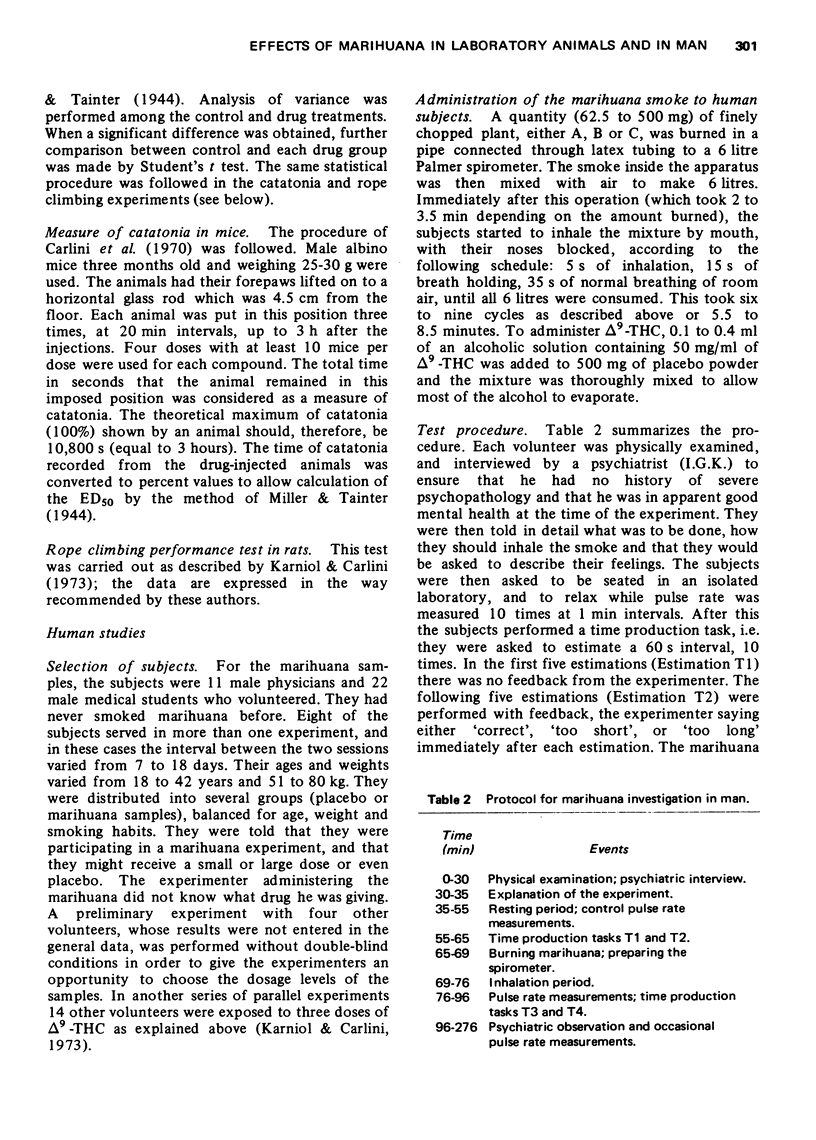
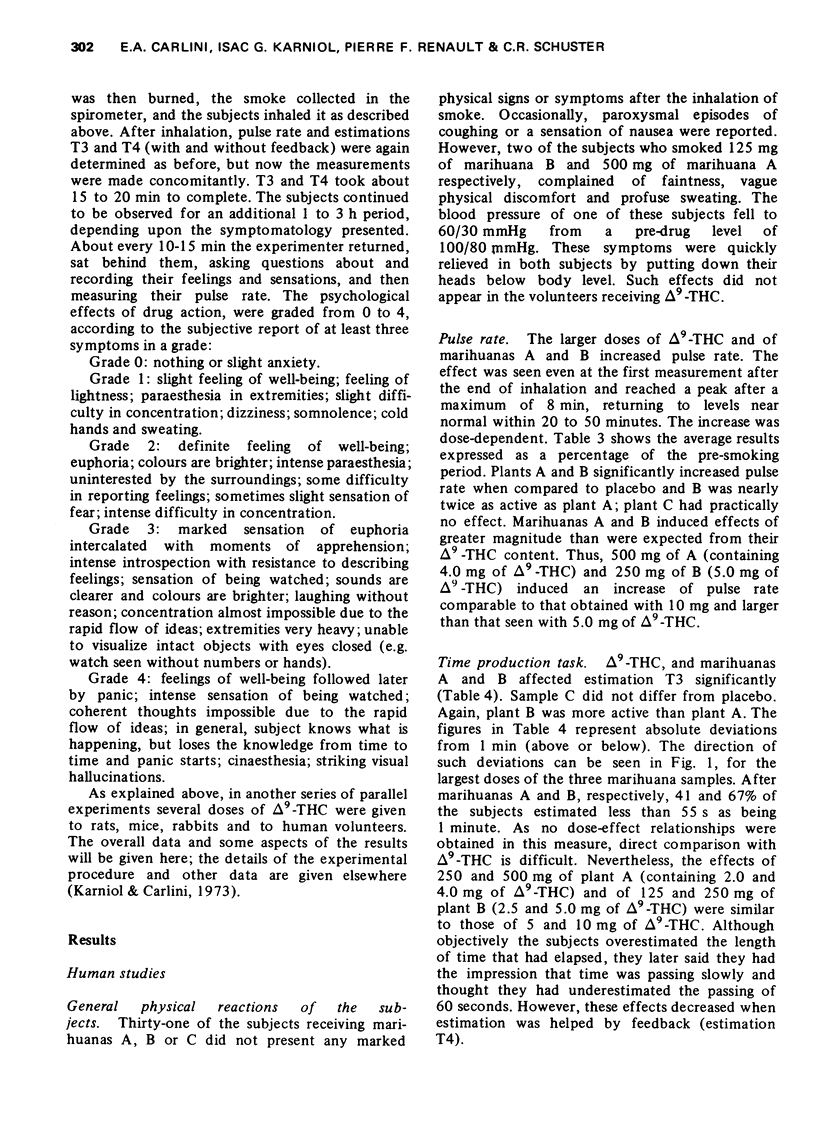

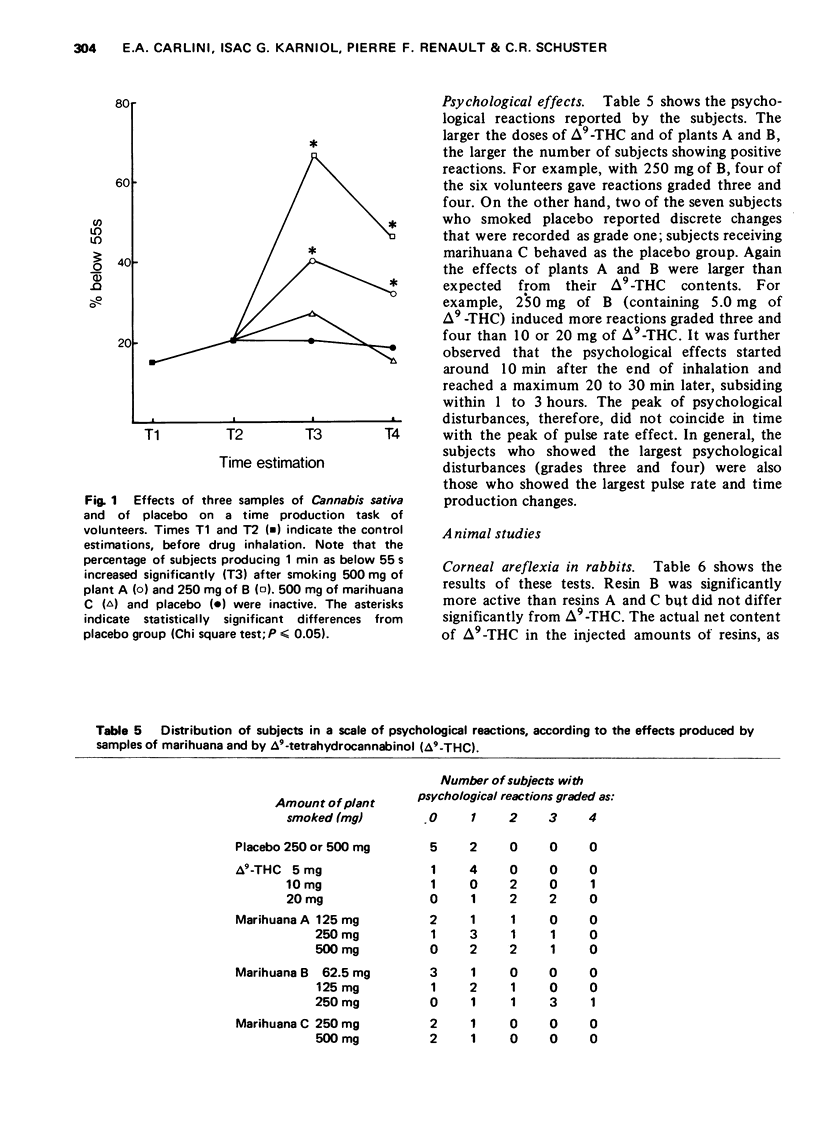

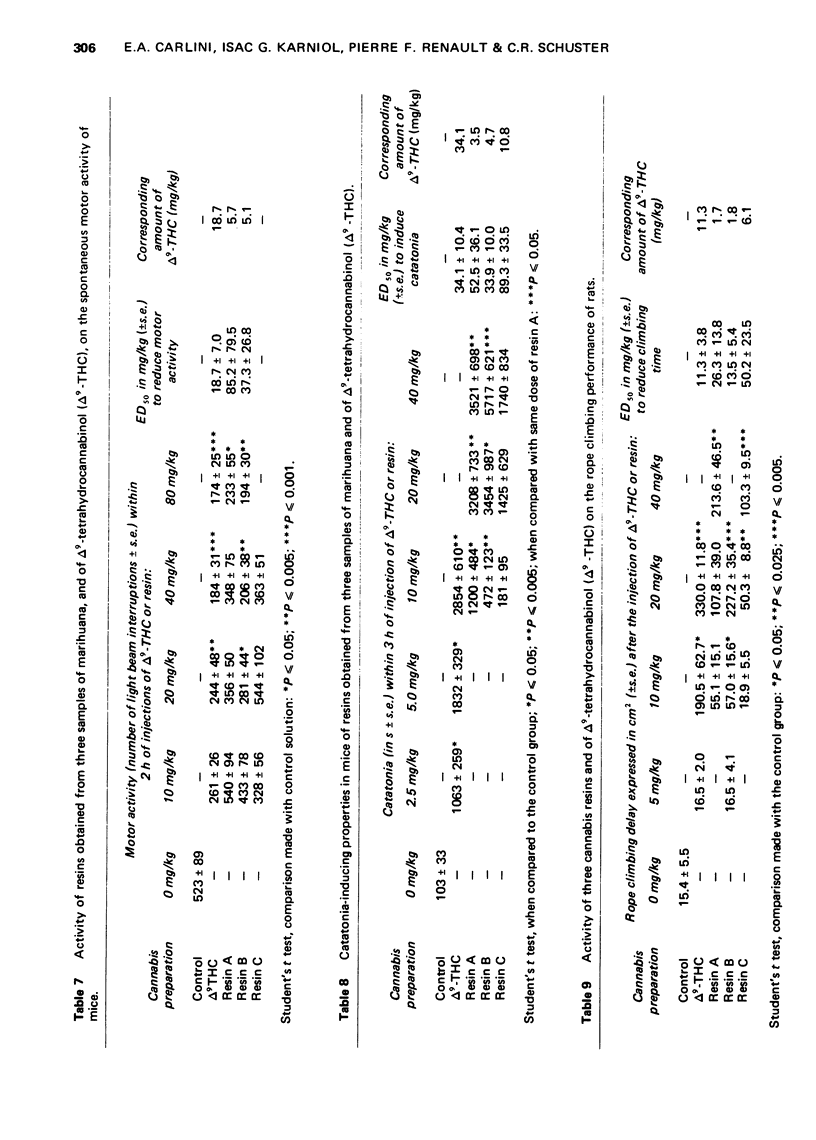
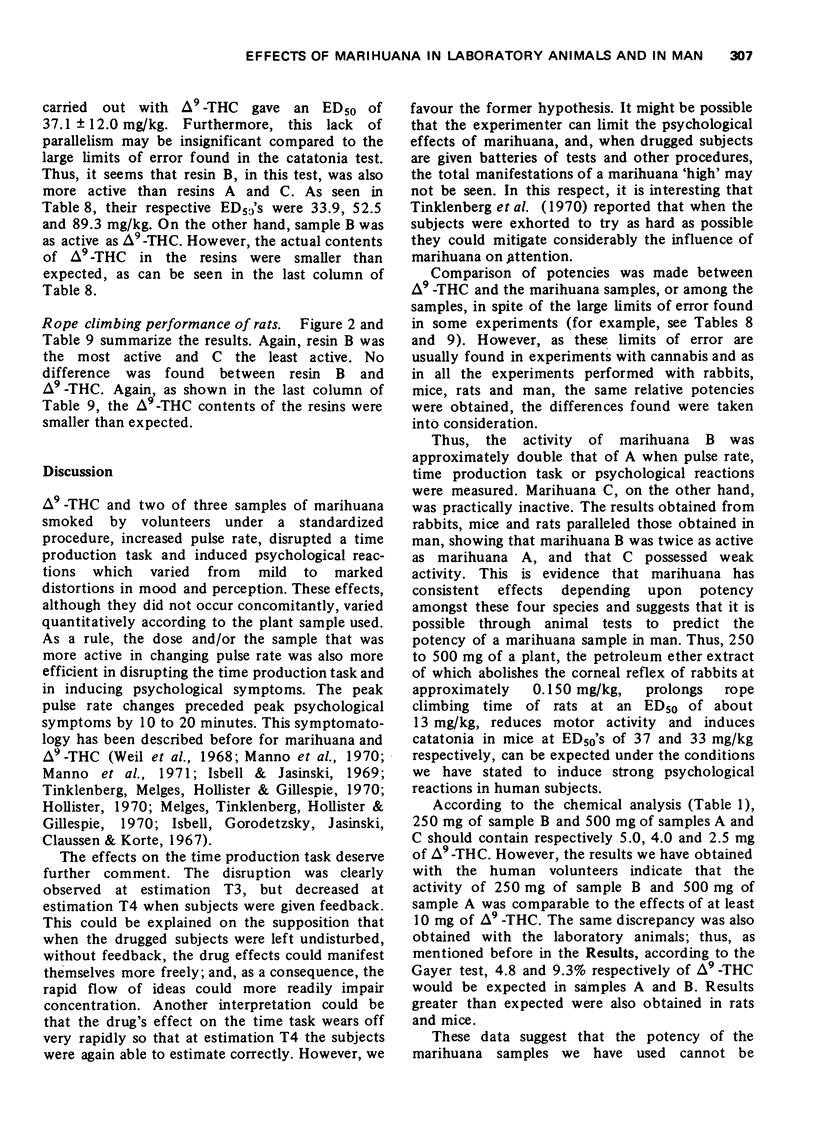


Selected References
These references are in PubMed. This may not be the complete list of references from this article.
- Caldwell D. F., Myers S. A., Domino E. F., Merriam P. E. Auditory and visual threshold effects of marihuana in man. Percept Mot Skills. 1969 Dec;29(3):755–759. doi: 10.2466/pms.1969.29.3.755. [DOI] [PubMed] [Google Scholar]
- Caldwell D. F., Myers S. A., Domino E. F., Merriam P. E. Auditory and visual threshold effects of marihuana in man: addendum. Percept Mot Skills. 1969 Dec;29(3):922–922. doi: 10.2466/pms.1969.29.3.922. [DOI] [PubMed] [Google Scholar]
- Carlini E. A., Kramer C. Effects of Cannabis sativa (marihuana) on maze performance of the rat. Psychopharmacologia. 1965 Mar 15;7(3):175–181. doi: 10.1007/BF00411216. [DOI] [PubMed] [Google Scholar]
- Carlini E. A., Santos M., Claussen U., Bieniek D., Korte F. Structure activity relationship of four tetrahydrocannabinols and the pharmacological activity of five semi-purified extracts of Cannabis sativa. Psychopharmacologia. 1970 Aug 19;18(1):82–93. doi: 10.1007/BF00402387. [DOI] [PubMed] [Google Scholar]
- Carlini E. A., Silva G. R. Lack of correlation between DAO inhibitory strength and catatonia-inducing property of aminoguanidine. Acta Physiol Lat Am. 1968;18(4):311–315. [PubMed] [Google Scholar]
- Crancer A., Jr, Dille J. M., Delay J. C., Wallace J. E., Haykin M. D. Comparison of the effects of marihuana and alcohol on simulated driving performance. Science. 1969 May 16;164(3881):851–854. doi: 10.1126/science.164.3881.851. [DOI] [PubMed] [Google Scholar]
- Hollister L. E. Tetrahydrocannabinol isomers and homologues: contrasted effects of smoking. Nature. 1970 Aug 29;227(5261):968–969. doi: 10.1038/227968a0. [DOI] [PubMed] [Google Scholar]
- Isbell H., Gorodetzsky C. W., Jasinski D., Claussen U., von Spulak F., Korte F. Effects of (--)delta-9-trans-tetrahydrocannabinol in man. Psychopharmacologia. 1967;11(2):184–188. doi: 10.1007/BF00401256. [DOI] [PubMed] [Google Scholar]
- Isbell H. II. Clinical pharmacology of marihuana. Pharmacol Rev. 1971 Dec;23(4):337–338. [PubMed] [Google Scholar]
- Isbell H., Jasinski D. R. A comparison of LSD-25 with (-)-delta-9-trans-tetrahydrocannabinol (THC) and attempted cross tolerance between LSD and THC. Psychopharmacologia. 1969;14(2):115–123. doi: 10.1007/BF00403684. [DOI] [PubMed] [Google Scholar]
- Karniol I. G., Carlini E. A. Comparative studies in man and in laboratory animals on 8 - and 9 -trans-tetrahydrocannabinol. Pharmacology. 1973;9(2):115–126. doi: 10.1159/000136375. [DOI] [PubMed] [Google Scholar]
- Karniol I. G., Carlini E. A. Pharmacological interaction between cannabidiol and delta 9-tetrahydrocannabinol. Psychopharmacologia. 1973 Oct 23;33(1):53–70. doi: 10.1007/BF00428793. [DOI] [PubMed] [Google Scholar]
- Karniol I. G., Carlini E. A. The content of (-) 9 -trans-tetrahydrocannabinol ( 9 -thc) does not explain all biological activity of some Brazilian marihuana samples. J Pharm Pharmacol. 1972 Oct;24(10):833–834. doi: 10.1111/j.2042-7158.1972.tb08897.x. [DOI] [PubMed] [Google Scholar]
- Kubena R. K., Barry H., 3rd Stimulus characteristics of marihuana components. Nature. 1972 Feb 18;235(5338):397–398. doi: 10.1038/235397a0. [DOI] [PubMed] [Google Scholar]
- Manno J. E., Kiplinger G. F., Haine S. E., Bennett I. F., Forney R. B. Comparative effects of smoking marihuana or placebo on human motor and mental performance. Clin Pharmacol Ther. 1970 Nov-Dec;11(6):808–815. doi: 10.1002/cpt1970116808. [DOI] [PubMed] [Google Scholar]
- Manno J. E., Kiplinger G. F., Scholz N., Forney R. B. The influence of alcohol and marihuana on motor and mental performance. Clin Pharmacol Ther. 1971 Mar-Apr;12(2):202–211. doi: 10.1002/cpt1971122part1202. [DOI] [PubMed] [Google Scholar]
- Melges F. T., Tinklenberg J. R., Hollister L. E., Gillespie H. K. Marihuana and temporal disintegration. Science. 1970 May 29;168(3935):1118–1120. doi: 10.1126/science.168.3935.1118. [DOI] [PubMed] [Google Scholar]
- Renault P. F., Schuster C. R., Heinrich R., Freeman D. X. Marihuana: standardized smoke administration and dose effect curves on heart rate in humans. Science. 1971 Nov 5;174(4009):589–591. doi: 10.1126/science.174.4009.589. [DOI] [PubMed] [Google Scholar]
- Tinklenberg J. R., Melges F. T., Hollister L. E., Gillespie H. K. Marijuana and immediate memory. Nature. 1970 Jun 20;226(5251):1171–1172. doi: 10.1038/2261171b0. [DOI] [PubMed] [Google Scholar]
- Vree T. B., Breimer D. D., van Ginneken C. A., van Rossum J. M. Identification in hashish of tetrahydrocannabinol, cannabidiol and cannabinol analogues with a methyl side-chain. J Pharm Pharmacol. 1972 Jan;24(1):7–12. doi: 10.1111/j.2042-7158.1972.tb08857.x. [DOI] [PubMed] [Google Scholar]
- Weil A. T., Zinberg N. E., Nelsen J. M. Clinical and psychological effects of marihuana in man. Science. 1968 Dec 13;162(3859):1234–1242. doi: 10.1126/science.162.3859.1234. [DOI] [PubMed] [Google Scholar]


